

InnerSuper. Tableofcontents. Biology in Motion. Biology Project - site map. Introduction to Evolutionary Biology. Introduction to Evolutionary Biology Version 2 Copyright © 1996-1997 by Chris Colby[Last Update: January 7, 1996] volution is the cornerstone of modern biology.
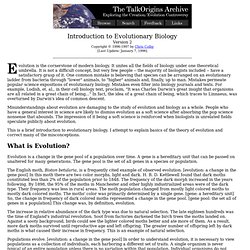
It unites all the fields of biology under one theoretical umbrella. It is not a difficult concept, but very few people -- the majority of biologists included -- have a satisfactory grasp of it. One common mistake is believing that species can be arranged on an evolutionary ladder from bacteria through "lower" animals, to "higher" animals and, finally, up to man. Mistakes permeate popular science expositions of evolutionary biology.
Misunderstandings about evolution are damaging to the study of evolution and biology as a whole. This is a brief introduction to evolutionary biology. What is Evolution? Natural History Notebooks Home Page. Scientists Uncover How Dainty Rhino Feet Support Huge Bodies. How do rhinos' dainty little pigeon-toed feet support their portly bodies?
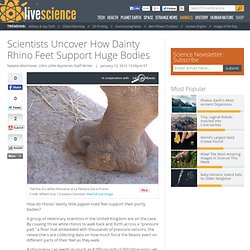
A group of veterinary scientists in the United Kingdom are on the case. By coaxing three white rhinos to walk back and forth across a "pressure pad," a floor mat embedded with thousands of pressure sensors, the researchers are collecting data on how much force the beasts exert on different parts of their feet as they walk. A rhinoceros can weigh as much as 8,000 pounds (3,600 kilograms), yet somehow, their feet manage to take all those tons in stride. Initial results show that, with each step, their toes feel peak pressures of 75 pounds per square inch (psi), and the pads of their feet, 15 psi. That's not so much. White rhinos in Namibia.Credit: Ikiwaner | Creative Commons In addition to figuring out how rhino feet manage this feat, the scientists are investigating how the beasts' locomotion differs from that of other large land mammals — in particular, elephants. For that matter, should anyone?
BBC Nature - Home. The Brain—Information about the Brain. 1 Introduction “I think, therefore I am.”

—René Descartes, 17th-century philosopher Few of us question the crucial importance of the brain. It is vital to our existence. Our brains enable us to think, as René Descartes so skillfully pointed out nearly 400 years ago. Brain's connective cells are much more than glue: Glia cells also regulate learning and memory. Glia cells, named for the Greek word for "glue," hold the brain's neurons together and protect the cells that determine our thoughts and behaviors, but scientists have long puzzled over their prominence in the activities of the brain dedicated to learning and memory. Now Tel Aviv University researchers say that glia cells are central to the brain's plasticity -- how the brain adapts, learns, and stores information.
According to Ph.D. student Maurizio De Pittà of TAU's Schools of Physics and Astronomy and Electrical Engineering, glia cells do much more than hold the brain together. A mechanism within the glia cells also sorts information for learning purposes, De Pittà says. Human Behavioral Biology. The "Johnny Depp Effect" - An evolutionary explanation for homosexuality. Who is more attractive as a mate?
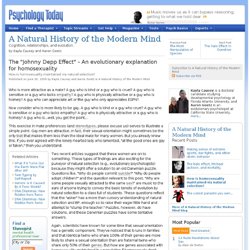
A guy who is kind or a guy who is cruel? A guy who is sensitive or a guy who lacks empathy ? A guy who is physically attractive or a guy who is homely? A guy who can appreciate art or the guy who only appreciates ESPN? Now consider who is more likely to be gay. 365 days: 2011 in review. For science — as for politics and economics — 2011 was a year of upheaval, the effects of which will reverberate for decades.
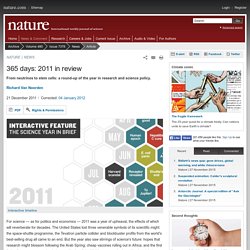
The United States lost three venerable symbols of its scientific might: the space-shuttle programme, the Tevatron particle collider and blockbuster profits from the world's best-selling drug all came to an end. But the year also saw stirrings of science's future: hopes that research might blossom following the Arab Spring; cheap vaccines rolling out in Africa; and the first fruits of genome sequencing being used in the clinic. All this was overshadowed by the triple trauma of Japan's devastating earthquake, tsunami and nuclear meltdown, and a continual chipping away at science funding as nations struggled with the financial crisis.
The stem-cell roller coaster It has been an emotional year for advocates and opponents of embryonic stem (ES) cell research. R. Powered down: the Tevatron collider was turned off for good in September. Puzzling over particles B. Gi. Loss of Predators Impacts Food Chain. A loss of species at the top of the food chain could have far-reaching effects on the environment, according to a study in the Journal Science.
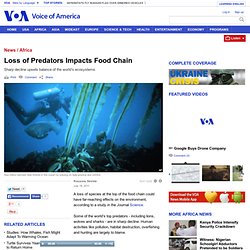
Some of the world’s top predators - including lions, wolves and sharks - are in sharp decline. Human activities like pollution, habitat destruction, overfishing and hunting are largely to blame. Jim Estes studies sea otters. The University of California, Santa Cruz professor of ecology and evolutionary biology says these furry marine mammals - once hunted to near extinction - are important to the health of coastal North Pacific ecosystems. “We have discovered that sea otters have an important limiting effect on sea urchins and that allows the kelp forest to persist," he says. Skeleton.png (1500×1200) 7.014 Introductory Biology.